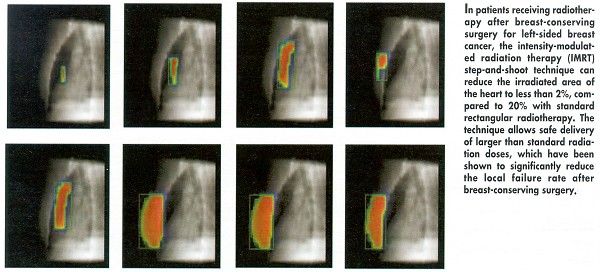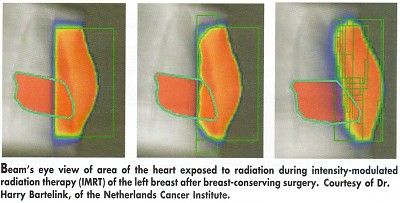Radiation Boost Cuts Local Failure Rate After Breast-Conserving Surgery
LISBON, Portugal-A 16-Gy boost to the tumor bed can slash the local recurrence rate by as much as 50% in younger women with breast cancer who undergo breast-conserving therapy, said Harry Bartelink, MD, PhD, of the Netherlands Cancer Institute, Amsterdam.
LISBON, PortugalA 16-Gy boost to the tumor bed can slash the local recurrence rate by as much as 50% in younger women with breast cancer who undergo breast-conserving therapy, said Harry Bartelink, MD, PhD, of the Netherlands Cancer Institute, Amsterdam.
Speaking at the 11th European Cancer Conference (ECCO), he reported the results of a phase III trial conducted by the European Organization for Research and Treatment of Cancer (EORTC).
The National Surgical Adjuvant Breast and Bowel Project (NSABP) and Scottish trials have convincingly shown that whole-breast irradiation after breast conservation treatment can reduce the odds of local recurrence by a factor of 4. However, the EORTC trial went a step further by asking whether 50 Gy was enough or whether an extra radiation dose might be even better.
To resolve this issue, the EORTC investigators randomly assigned 5,569 women with breast tumors up to 5 cm in size to receive whole-breast irradiation alone or supplemented by a 16-Gy boost to the tumor bed. Microscopically complete resection had been achieved in 95% of study participants.
"Only 30% of our postmenopausal patients received tamoxifen (Nolvadex) and only 12% received chemotherapy, so these were really prognostically favorable tumors," Dr. Bartelink commented.
After a median follow-up of 5.1 years, Dr. Bartelink and his fellow investigators found that the 16-Gy boost strikingly reduced the local failure rate by nearly a factor of 2. No-boost patients experienced 182 local recurrences, compared with 109 local recurrences among boost patients (for a complete report, see N Engl J Med 345:1378-1387, 2001).
"About half of these recurrences are located outside the primary tumor bed, so even if you do a quadrantectomy, you need whole-breast irradiation," Dr. Bartelink said.
Local control is clearly related to age, he said: "The younger you are, the worse your prognosis is in terms of local control." Dr. Bartelink pointed out that women under age 40 who received whole-breast irradiation alone had a local recurrence rate of 20%, compared with 9% for those who received the additional radiation dose.
Indeed, among younger women, the boost transformed a hazard ratio of 1.67 into a hazard ratio of 0.51. In contrast, women over 60 experienced no significant benefit from the extra dose.
At 5 years, more than 91% of patients in both study arms were still alive. "It is too early to say whether the boost has an effect on survival; we’ll have to wait for the 10-year follow-up results," he said.
Dr. Bartelink acknowledged that an extra radiation dose can adversely affect the cosmetic outcome. He emphasized, however, that other factors, such as inferior location of the tumor and increased excision volume, were more important determinants of the appearance of the treated breast.
Lowering Heart Risk
A major drawback to radiation therapy, Dr. Bartelink said, is that irradiation of the left breast can culminate in a doubling of mortality from ischemic heart disease. The magnitude of increased risk depends not only on the total radiation dose and volume of tissue irradiated but also on the dose per fraction.
However, the danger of long-term cardiac complications can be largely overcome with the new technique known as intensity-modulated radiation therapy (IMRT). With IMRT, radiotherapists use multileaf collimators to divide one wide beam into many smaller beam segments, or bixels. They can then individually determine the intensity of each bixel and deliver high-dose radiation to the precise spot where it is needed, while sparing critical normal tissue.

Dr. Bartelink explained that, during standard rectangular radiotherapy for left-sided breast cancer, as much as 20% of the myocardium is irradiated. In contrast, he noted, with IMRT, less than 2% of the myocardial tissue is exposed to radiation.

Dr. Bartelink and his Netherlands Cancer Institute colleagues have found that using the IMRT "step-and-shoot" technique to avoid the heart can reduce the risk of myocardial infarction to less than 1%, down from 7% with standard radiotherapy and 3% with three-dimensional conformal radiotherapy.
Giredestrant Combo Yields Positive PFS in Subgroups After CDK4/6i in ER+/HER2– Breast Cancer
December 13th 2025“The magnitude of clinical benefit was clinically meaningful and consistent, and was regardless of PIK3CA mutations or alterations in the PIK3CA pathway, duration of prior CDK4/6 inhibitors, including patients who progress within 6 to 12 months, and the choice of prior CDK4/6 inhibitors,” said Hope S. Rugo, MD.